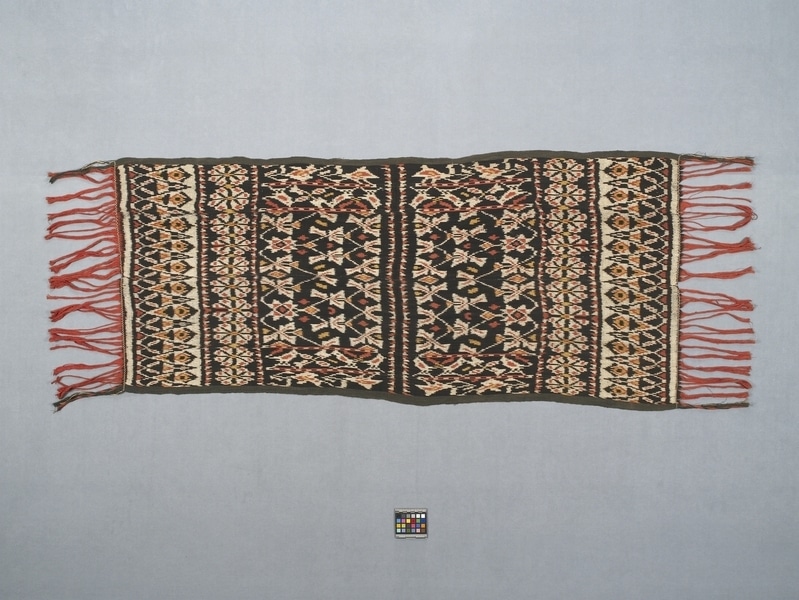Shawl Item Number: Ic10 from the MOA: University of British Columbia

Description
Woven cotton warp ikat textile with multi-strand rolled cotton thread fringe. Two pieces sewn together lengthwise at centre with brown thread. Designs from each orange/red fringe end are duplicated to centre. Closest to the fringe is a bar of triangle-like shapes in brown on beige with orange/red and yellow detail. In between triangles are highly stylized standing figures. In the second section are 8 petaled beige flowers on brown with orange/red and yellow detail. Main sections from centre have general shapes of x's, stars (orange/red on beige on brown) and 4 ladder-like bars. Centre two rows of alternating orange/red and beige vague triangles on brown ground. Lengthwise border and wefts are brown. Fringe at edges brown over-dye on one edge onto fringe and on other edge orange/red over-dye on weaving from fringe. Braided brown and beige threads along edge of weaving at fringes.
History Of Use
In Indonesia textiles have social and spiritual significance. Woven textiles are seen as a metaphor for life; the interweaving symbolizes the predestined elements of life (warp) interwoven with life's variables (weft). Traditionally, ikat woven textiles revealed the social rank and kin association of the wearer; and many designs were owned. The ritual display and exchange of these textiles was very important particularly in rites of passage ceremonies. For the most part, Indonesian clothing is based on a rectangle, which is draped over the body or sewn in a tube. Roti ikat cloths such as this one are worn by women as a long fringed shoulder cloth. The design is primarily influenced by Indian patola textiles, once used as tokens of alliance with the Dutch, with the elite claiming exclusive use of these designs.
Iconographic Meaning
The triangular motif is called 'tumpal', an ancient symbol found all over Southeast Asia and India. The 8 petaled flowers are also from the Indian patola designs. The branching flower motif is called "dula buna".
Cultural Context
Worn by women at ceremonies.
Specific Techniques
The preparation and weaving of roti ikats is complex and time-consuming. The yarn is pretreated for 9 days in a cold solution containing ashes, powdered seeds (sterculia foetida l.) and bark (aporosa frutescens bl.) to allow the dye (red) to penetrate the cotton. The weaving is done by women. The warp is divided into 2 panels inside each other, both are looped so that all 4 design sections can be tied at once. Gebang palm leaf bast is used for resist ties, often waxed. Dyeing is also done by women. The indigo usually takes 11 nights, with days spent drying in the sun, and rinsed every 3 days. The fringes are often tied in a plaited bast bag to resist the dye. The process of red (morinda: aporosa frutescens) dyeing takes months. The yellow (cudriana: loranthus sp.; and curcuma) is achieved by repeated dipping. A final sizing and fixing treatment is applied before drying. A monochromatic weft is used (Larsen). 'Totally handspun and vegetable dyed' (collector's notes).
Item History
- Made in Roti, Nusa Tenggara Timur, Indonesia before 1980
- Collected before 1980
- Owned by Dorian Rae before October 31, 1980
- Received from Museum of Anthropology Shop Volunteers (Funding source) and Dorian Rae (Seller) on October 31, 1980
What
Who
- Culture
- Rotinese
- Previous Owner
- Dorian Rae
- Received from
- Museum of Anthropology Shop Volunteers (Funding source) and Dorian Rae (Seller)
Where
- Holding Institution
- MOA: University of British Columbia
- Made in
- Roti, Nusa Tenggara Timur, Indonesia
When
- Creation Date
- before 1980
- Collection Date
- before 1980
- Ownership Date
- before October 31, 1980
- Acquisition Date
- on October 31, 1980
Other
- Item Classes
- textiles
- Condition
- good
- Accession Number
- 0677/0012